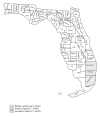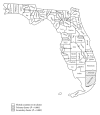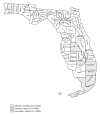Clusters of adolescent and young adult thyroid cancer in Florida counties
- PMID: 24868551
- PMCID: PMC4020503
- DOI: 10.1155/2014/832573
Clusters of adolescent and young adult thyroid cancer in Florida counties
Abstract
Background: Thyroid cancer is a common cancer in adolescents and young adults ranking 4th in frequency. Thyroid cancer has captured the interest of epidemiologists because of its strong association to environmental factors. The goal of this study is to identify thyroid cancer clusters in Florida for the period 2000-2008. This will guide further discovery of potential risk factors within areas of the cluster compared to areas not in cluster.
Methods: Thyroid cancer cases for ages 15-39 were obtained from the Florida Cancer Data System. Next, using the purely spatial Poisson analysis function in SaTScan, the geographic distribution of thyroid cancer cases by county was assessed for clusters. The reference population was obtained from the Census Bureau 2010, which enabled controlling for population age, sex, and race.
Results: Two statistically significant clusters of thyroid cancer clusters were found in Florida: one in southern Florida (SF) (relative risk of 1.26; P value of <0.001) and the other in northwestern Florida (NWF) (relative risk of 1.71; P value of 0.012). These clusters persisted after controlling for demographics including sex, age, race.
Conclusion: In summary, we found evidence of thyroid cancer clustering in South Florida and North West Florida for adolescents and young adult.
Figures




Similar articles
-
Epidemiologic mapping of Florida childhood cancer clusters.Pediatr Blood Cancer. 2010 Apr;54(4):511-8. doi: 10.1002/pbc.22403. Pediatr Blood Cancer. 2010. PMID: 20054842
-
An exploratory investigation of geographic disparities of stroke prevalence in Florida using circular and flexible spatial scan statistics.PLoS One. 2019 Aug 30;14(8):e0218708. doi: 10.1371/journal.pone.0218708. eCollection 2019. PLoS One. 2019. PMID: 31469839 Free PMC article.
-
Italian cancer figures, report 2012: Cancer in children and adolescents.Epidemiol Prev. 2013 Jan-Feb;37(1 Suppl 1):1-225. Epidemiol Prev. 2013. PMID: 23585445 English, Italian.
-
Primary malignancies of the thyroid: epidemiologic analysis of the Florida Cancer Data System registry.Ann Epidemiol. 2000 Jan;10(1):24-30. doi: 10.1016/s1047-2797(99)00044-7. Ann Epidemiol. 2000. PMID: 10658686
-
Impact of enhanced detection on the increase in thyroid cancer incidence in the United States: review of incidence trends by socioeconomic status within the surveillance, epidemiology, and end results registry, 1980-2008.Thyroid. 2013 Jan;23(1):103-10. doi: 10.1089/thy.2012.0392. Thyroid. 2013. PMID: 23043274 Free PMC article. Review.
Cited by
-
Spatial-Temporal Cluster Analysis of Childhood Cancer in California.Epidemiology. 2020 Mar;31(2):214-223. doi: 10.1097/EDE.0000000000001121. Epidemiology. 2020. PMID: 31596791 Free PMC article.
-
Epidemic characteristics and spatio-temporal patterns of scrub typhus during 2006-2013 in Tai'an, Northern China.Epidemiol Infect. 2015 Aug;143(11):2451-8. doi: 10.1017/S0950268814003598. Epub 2014 Dec 29. Epidemiol Infect. 2015. PMID: 25543665 Free PMC article.
-
Cluster Analysis: A New Approach for Identification of Underlying Risk Factors and Demographic Features of First Trimester Pregnancy Women.J Clin Med. 2020 Jul 15;9(7):2247. doi: 10.3390/jcm9072247. J Clin Med. 2020. PMID: 32679845 Free PMC article.
References
-
- National Cancer Institute. Adolescents and young adults (AYA) with cancer Secondary Adolescents and young adults (AYA) with cancer. 2012, http://www.cancer.gov/cancertopics/aya.
-
- Bleyer A. Young adult oncology: the patients and their survival challenges. CA: A Cancer Journal for Clinicians. 2007;57(4):242–255. - PubMed
-
- Ries LAG, Melbert D, Krapcho M. SEER cancer statistics review, 1975–2005. Secondary SEER cancer statistics review, 1975–2005. 2008, http://seer.cancer.gov/csr/1975_2005.
-
- Yu G, Li J, Branovan D, McCormick S, Schantz SP. Thyroid cancer incidence and survival in the national cancer institute surveillance, epidemiology, and end results race/ethnicity groups. Thyroid. 2010;20(5):465–473. - PubMed
-
- UCSW Group. United States Cancer Statistics: 1999–2004 incidence and mortality web based report. Secondary United States Cancer Statistics: 1999–2004 incidence and mortality web based report. 2008, http://www.cdc.gov/uscs.
MeSH terms
LinkOut - more resources
Full Text Sources
Other Literature Sources
Medical

